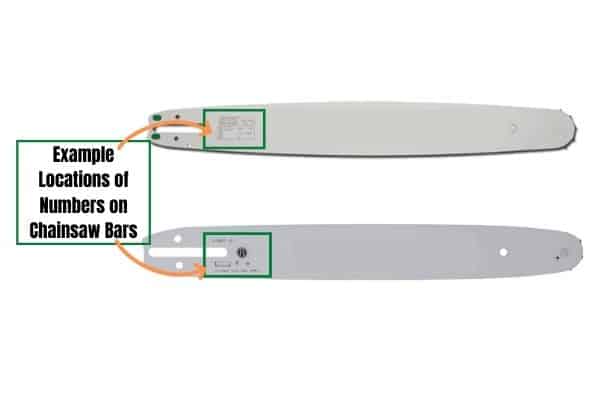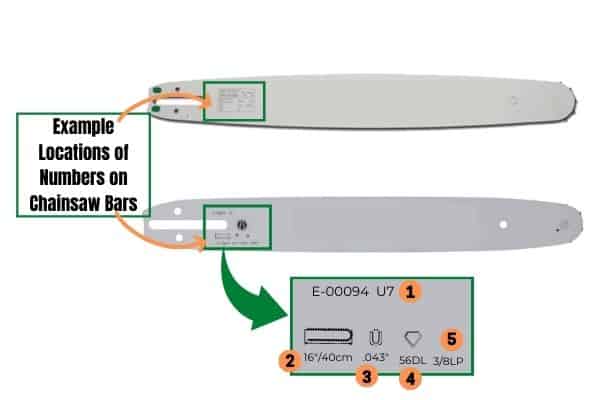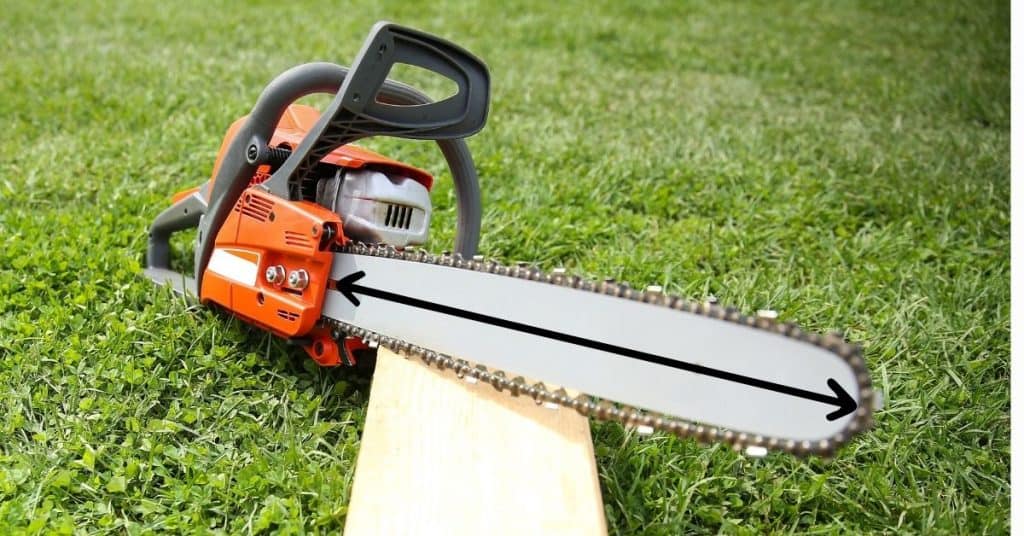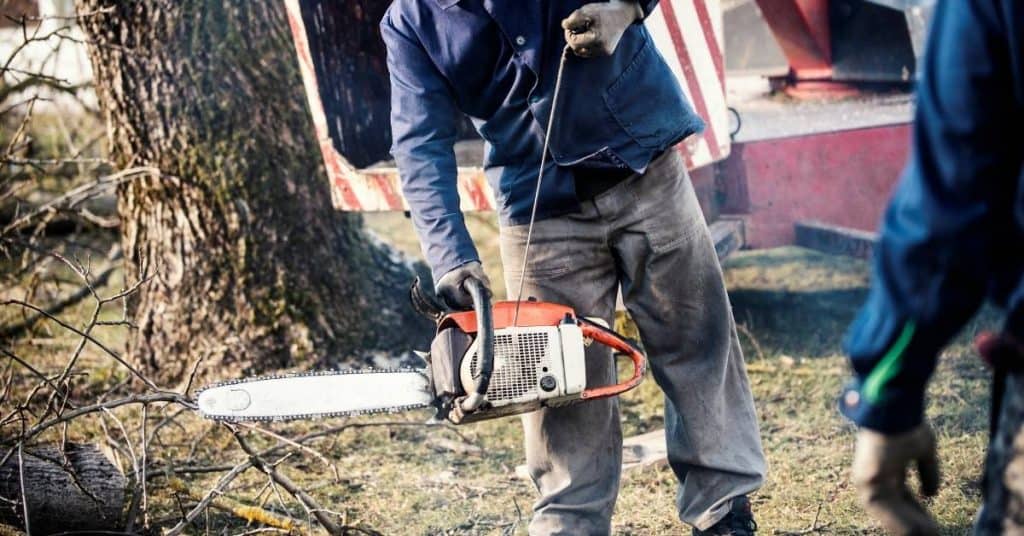Need to replace your chainsaw bar, but not sure what size you need? Learn how to measure a chainsaw bar the right way. Chainsaw bars come in many different sizes and dimensions, making it difficult to find the right one for your needs.
You can’t just put any size chainsaw bar on any chainsaw. This article will teach you how to measure chainsaw bars so you’ll never have to worry about getting the correct size again!
What is a Chainsaw Bar?
A chainsaw bar is a long metal shaft that’s attached to the chainsaw engine. Also called a chainsaw blade, its job is to guide the chain as it cuts. There are different types and sizes of chainsaw bars available on the market.
The most common type of bar is a solid bar with a rounded tip. Solid bars with replacement tips, bars with a smaller nose radius, and laminated bars. The type of bar you need depends on the cutting you will be doing.
How to Measure a Chainsaw Bar
There are 2 measurements to a chainsaw bar: the actual length or the true length of the bar and the cutting length, also known as the effective cutting length.
How to measure a bar manually
The true length of a chainsaw bar is the entire length of the bar. To get this measurement, the bar needs to be removed from the chainsaw. Once the bar is removed, lay it flat and measure the entire length tip to tip. The exact measurement is the true length of your chainsaw bar.
The effective cutting length, also known as the called length, is the usable length of the bar. This is the length of the bar that is sticking out of the chainsaw and the part that actually does the cutting.

To measure the cutting length, you measure from the blade’s tip to where the blade goes into the chainsaw. Measure from the tip of the bar to the base of the chainsaw and round that measurement up to the nearest even whole number. For example, if you got a measurement of 16 ½”, you would round up to 18. The replacement bar size you would want is size 18.
How to Measure the Chain
To know the length of chain you need, you need a couple of different measurements: the pitch, the gauge, and the number of drive links.
Measuring Pitch
Pitch determines how close together the links on a chainsaw chain are. It’s measured in inches and is the distance between two drive links. This can be measured by taking the distance between 3 rivets and then dividing by 2. The result is the pitch.
The greater distance between links or the larger pitch allows for more aggressive cutting. The most common pitch size is ⅜” and makes up the majority of medium-use, non-professional chainsaws.
Measuring Gauge
The gauge tells you the size of the chain. It is the width of the drive links. It is important to measure the gauge correctly because this is the groove that fits onto the bar.
This measurement can be found on the tool itself, the user’s manual, or measured with accurate calipers. The most common gauge size is 0.050”.
Drive Links
Lastly, you want to count each drive link in the chain. Once you have all of these measurements, you can easily find the correct replacement chain that fits your chainsaw perfectly.
How to Find the Info on the Bar

Never guess the size of your chain or bar. The bar is easy to measure, and You can find the other measurements on the bar itself. They are usually stamped onto the bar towards the end, where it goes into the chainsaw.
Sometimes the measurements are very clearly marked, and sometimes they are with many other numbers, so it is important to know what numbers you should be looking for.
What do the numbers mean on a chainsaw bar?

- The long number that may or may not have letters is the guide bar code.
- The guide bar measurement in cm or inches or both. It can be seen inside the image of a bar or next to an image of a bar.
- The width of the guide or the gauge in mm/inches.
- The number of teeth, sometimes seen as a whole number with an x after it.
- The pitch of the chain in inches, sometimes shown as a fraction.
How to Know When to Replace Chainsaw Bar
If your chainsaw bar is damaged or bent, it is time to replace it. Other signs that your chainsaw bar has too much wear and tear are that the chain has gaps or is loose on the bar. Look out for any rigid areas where the chain could get stuck and file them down if possible.
If your chainsaw bar is not being properly maintained, it will wear a lot faster. Be sure to do routine maintenance after every use to get the most life out of your chainsaw bar.
How to Choose the Chainsaw Bar
There are a few different types of chainsaw bars to choose from.
Solid Bar: made from one solid piece of metal. They typically are higher in strength.
There are 2 types of Solid Bars: solid bar with replacement nose and solid bar with the hard nose. The nose of the chainsaw bar is usually what wears quicker than the rest of the bar. You can choose a bar that has a nose that is removable and replaceable.
Laminated Bars: made from multiple pieces of metal laminated together. They have a steel core. These bars are going to be more flexible.
Chainsaws and Blade Sizes
The cutting length of a chainsaw blade and the power of the chainsaw engine determine the type of work you can do with a particular chainsaw.
For example, a long chainsaw bar is powerful enough to cut large trees, but a shorter one isn’t. A short chainsaw bar can cut through smaller wood because the engine doesn’t have to work as hard to move it.
Lengths of different types of chainsaw blades – Electric vs Gas-Powered
The length of a chainsaw blade also varies by the type of power that it runs on. Generally speaking, electric models are smaller in size and easier to use around your backyard when compared with gas-powered chainsaws; however, those who want more power should consider using gas-powered chainsaws.
The higher-powered gas chainsaws will require a longer chainsaw blade, while the electric chainsaws are going to be shorter. There are different types of lengths for both gas and electric chainsaws.
Safety Tips for Using a Chainsaw in General
Be sure always to wear protective gear while using a chainsaw. This includes eye protection, gloves, and ear protection, particularly when more than one person is working with the chainsaw at a time.
Chainsaws can be dangerous if they are not properly maintained or used responsibly; however, they also provide a great benefit as long as you know how to use them properly. Keep up with the routine maintenance on your chainsaw, and you will have your chainsaw ready to go whenever you are. Simple maintenance can be a reason your chainsaw won’t start.
FAQ’s Regarding Chainsaw Bars and Chains
1. Can I use any blade on my chainsaw?
You can’t use any blade size on your chainsaw. You need to properly measure the bar you have and get a chainsaw bar of the same size. Each brand of chainsaw has a standard size for its bars and blades. You can tell what type of blade you have by looking at the end that attaches to the chainsaw bar itself.
2. How do you measure the length of a chainsaw chain?
To measure a chainsaw chain, you need to determine the pitch of the chainsaw. This is done by looking at the piece you remove when installing or changing out your chainsaw blades. The number printed on it will tell you how many links there are in one pitch of the chainsaw chain.
3. How to tell if a chainsaw bar is bad?
To tell if a chainsaw bar is bad or needs replacing if you notice wear in spots. If the bar is more worn in some areas, it will cause uneven cutting and damage the chain.
4. Why do you need to measure a chainsaw bar?
To measure a chainsaw bar is to confirm that the correct size is being used. It will ensure an easier time when installing or changing out the chain. Refer to your owner’s manual for specific instructions on this process.
5. Why shouldn’t you go for a longer bar than you need?
The length of chainsaw bar you can use on a particular chainsaw depends on your chainsaw’s power. The more power a chainsaw has the longer the bar it can handle. Always refer to your owner’s manual or manufacturer recommendations for the size of the bar that you can use with your chainsaw.
Conclusion
The chainsaw bar length is what determines how much wood you can cut. You can easily measure the length of the bar. When measuring manually, put the measuring tape at the end of the bar against the frame of the chainsaw and measure down to the tip of the blade, then round up to the nearest even number (i.e., 14 3/4″ would round to 16 inches). The rounded number is the size of your bar.
It is important to measure your existing bar when purchasing a new one; putting on the wrong size can put too much strain on the engine. You want to make sure you get the correct length bar for your engine type and size.
To find out the size chain you need you will also need to know the gauge, pitch, and the number of drive links. These measurements can be found on the chainsaw bar itself and are etched in near the user end of the bar.


